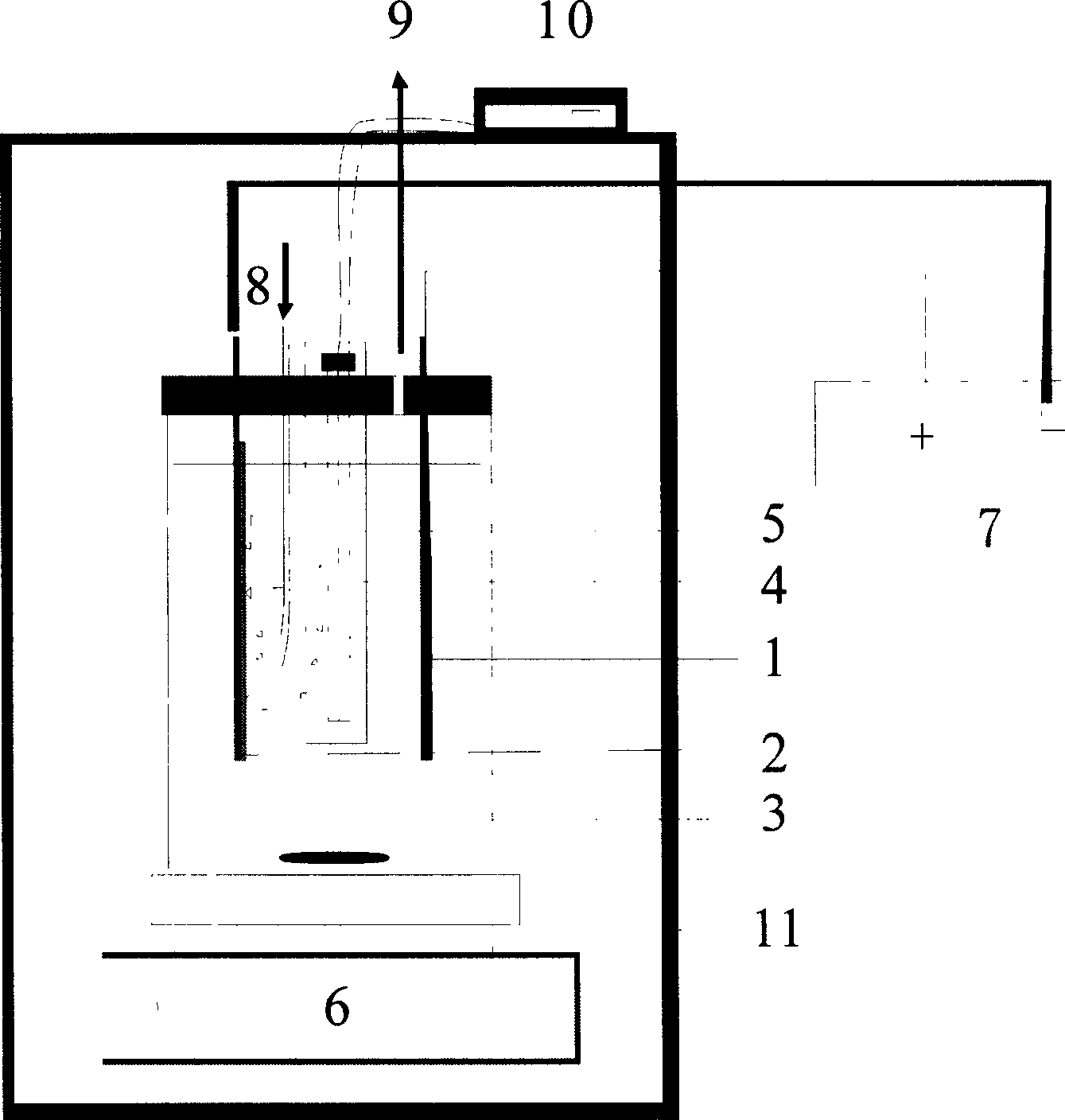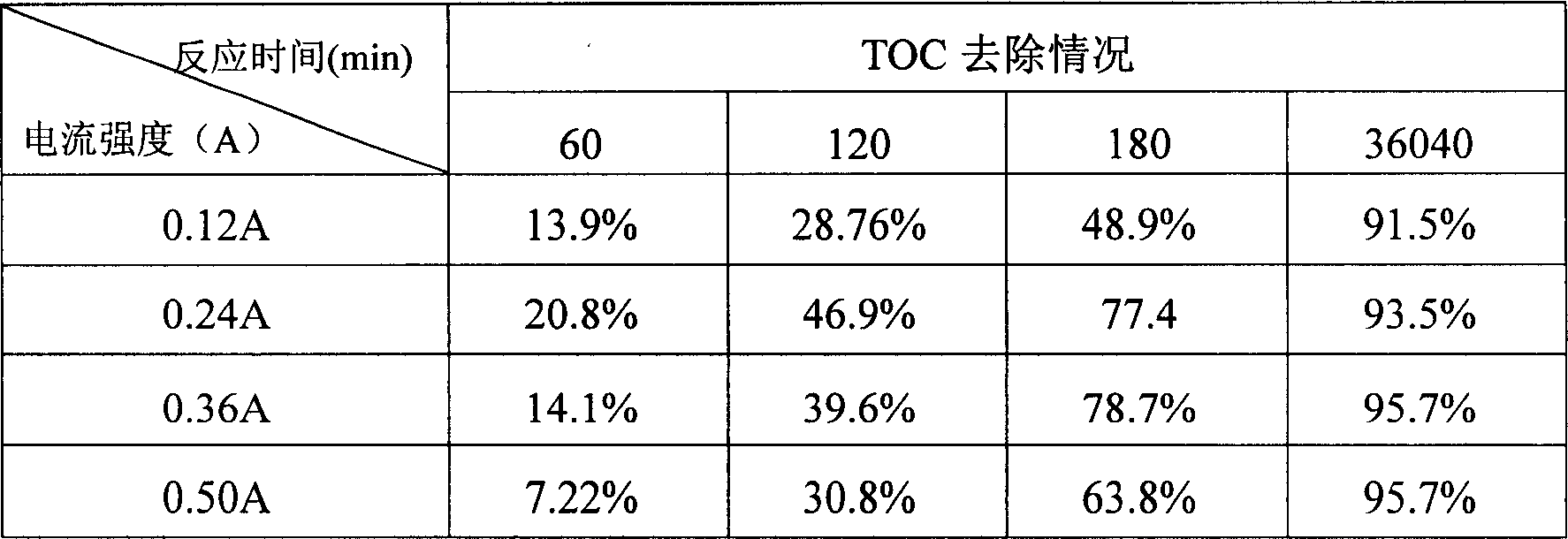Method and apparatus for highly efficient removal of water organisms by utilizing photoelectric Fenton reaction
A Fenton reaction and water removal technology, applied in the direction of light water/sewage treatment, etc., can solve the problems of consuming many chemicals and raw materials, secondary pollution, complicated operation, etc., and achieve good physical and chemical properties, easy operation, and operation methods. simple effect
- Summary
- Abstract
- Description
- Claims
- Application Information
AI Technical Summary
Problems solved by technology
Method used
Image
Examples
Embodiment 1
[0019] Embodiment 1. Different treatment process is to the removal of organic matter
[0020] Reaction target solution volume: 450ml
[0021] Reaction target solution concentration: acid red B200mg / L
[0022] Solution initial pH: 3.00
[0023] Plate area: 27cm 2
[0024] Electrolyte concentration: 0.05M Na 2 SO 4
[0025] Oxygen flow rate: 100ml / min
[0026] Response time: 360min
[0027] They are anodic oxidation (the cathode is a titanium ruthenium mesh electrode), activated carbon fiber (ACF) adsorption (without electricity), and electric Fenton oxidation (without light, Fe 2+ 1mM), and photoelectric Fenton oxidation (Fe 2+ 1mM, plus ultraviolet light) to treat Acid Red B solution, the removal of TOC before and after treatment is shown in Table 1.
[0028] time
[0029] It can be seen from Example 1 that the photoelectric Fenton reaction can effectively degrade and remove organic pollutants in water, and its removal efficiency is higher than that of act...
Embodiment 2
[0030] Embodiment 2. Influence of current intensity in photoelectric Fenton reaction process
[0031] Reaction target solution volume: 450ml
[0032] Reaction target solution concentration: acid red B 200mg / L
[0033] Solution initial pH: 3.00
[0034] Electrolyte concentration: 0.05M Na 2 SO 4
[0035] Oxygen flow rate: 100ml / min
[0036] Current intensity: 0.12A, 0.24A, 0.36A, 0.50A
[0037] Response time: 360min
[0038] The removal of TOC before and after treatment is shown in Table 2.
[0039] Table 2 Effect of current intensity on TOC removal in Example 2
[0040]
[0041] It can be seen from Example 2 that as the current intensity increases, the removal rate of TOC also increases correspondingly, which is due to the increase in the amount of hydrogen peroxide produced.
Embodiment 3
[0042] Example 3. Photoelectric Fenton removal of acid red B under different gas conditions
[0043] Reaction target solution volume: 450ml
[0044] Reaction target solution concentration: acid red B 200mg / L
[0045] Solution initial pH: 3.00
[0046] Plate area: 27cm 2
[0047] Electrolyte concentration: 0.05M Na 2 SO 4
[0048] Gas type: Ar, O 2
[0049] Gas flow rate: 100ml / min
[0050] Current intensity: 360mA
[0051] The Acid Red B solution was treated when the gases were oxygen and argon respectively, and the removal of TOC before and after treatment is shown in Table 3.
[0052] time
[0053] As can be seen from Example 3, the type of gas introduced has a certain impact on photoelectric Fenton degradation of Acid Red B, and the introduction of oxygen is beneficial to the better mineralization and removal of organic matter, but when argon gas is introduced, it also has a certain effect. Good removal effect, which is due to the evolution of oxygen fro...
PUM
| Property | Measurement | Unit |
|---|---|---|
| strength | aaaaa | aaaaa |
| strength | aaaaa | aaaaa |
Abstract
Description
Claims
Application Information
 Login to View More
Login to View More - R&D
- Intellectual Property
- Life Sciences
- Materials
- Tech Scout
- Unparalleled Data Quality
- Higher Quality Content
- 60% Fewer Hallucinations
Browse by: Latest US Patents, China's latest patents, Technical Efficacy Thesaurus, Application Domain, Technology Topic, Popular Technical Reports.
© 2025 PatSnap. All rights reserved.Legal|Privacy policy|Modern Slavery Act Transparency Statement|Sitemap|About US| Contact US: help@patsnap.com


